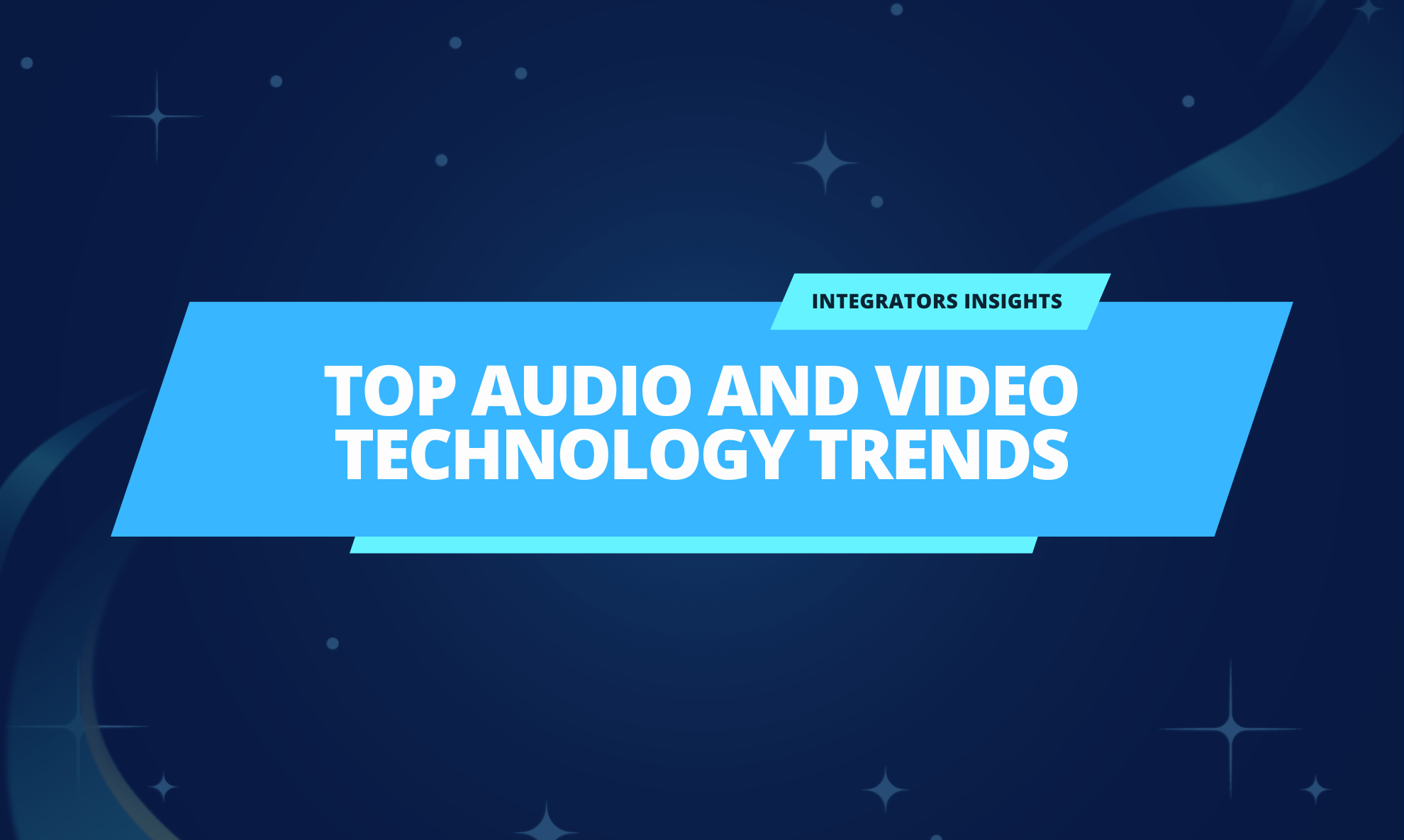What’s driving Audio-Visual technology nowadays? Why AV industry is taking a rapid boom? With the industry projected to be worth almost $80 billion by 2028, it seems fair to say AV isn’t just a niche.
No longer merely the domain of communication-oriented businesses, shifting AV use cases has global impacts.
Table of contents:
Here are nine of the biggest ways it’s transforming the workplace:
1) AV-as-a-Service Drives Recurring Revenue
The AV industry seems to have taken some cues from other tech domains. Just as software shifted to an as-a-service model, AV companies are now offering AV-as-a-Service (AVaaS).
In short, AVaaS is a subscription-based model that allows your clients to access the AV services you offer.
With AVaaS models, integrators can enjoy a distinct competitive advantage by letting businesses lease AV hardware and software on a rolling basis. This reduces upfront costs for end users, making it easier to attract new customers with competitive offerings.
AVaaS can also help you as an integrator to be more flexible. By defining clear service-level agreements, you can precisely tune your offerings and deliver quality services. In return, you come closer to capturing one of the holy grails of profitability: recurring revenue.
Read our blog on how a network monitoring system can help commercial integrators grow recurring revenue.
2) Digital Signage Makes Workplaces More Informative
Digital displays are becoming integral to workspaces. From corporate communication to wayfinding and branding, digital signage enhances engagement and information dissemination. The reason why digital signage works so effectively is because it makes employees and visitors feel welcome and makes it easier for people to navigate the office environment.
At the same time, nothing looks worse than a digital display that isn’t working or displaying some sort of error code.
Businesses usually require professional services for setting up, installing, monitoring and maintaining digital signage technology.
Thankfully, integrators are not alone in providing services for these devices. There are affordable network monitoring tools for integrators to help you monitor and maintain digital signage technology so you can offer value-added services around these systems.
To sum up, AV service providers can use digital signage to capture new revenue streams. For instance, simply observing how an office or retail center works may make it easy to suggest signage-powered improvements. In other words, you can offer added value by helping your clients be more efficient.
3) Immersive Experiences Facilitate Communication
AV technologies are integral to creating immersive environments. Things like Virtual Reality (VR) and Augmented Reality (AR) can’t exist without capable network monitoring. Although these experiences enhance training, collaboration, and creativity, using personal devices doesn’t cut it.
The issue is that effective workplace AV and VR depend on a high degree of connectivity.
For example, companies often rely on an immersive learning environment to conduct employee training. On the one hand, to create these immersive experience, numerous systems must work simultaneously. On the other hand, these experiences must be available across various platforms to enhance immersive customer experience. Therefore, the technology you use becomes crucial, necessitating reliable solutions to meet these complex requirements.
As a result, you require a cetralized monitoring system that can automatically detect and seamlessly integrate all these systems.
4) Smart Workplaces Boost Productivity
Modern workspaces are often multifunctional facilities. Even when companies own dedicated facilities, they may have to divvy them up for distinct uses and workflows.
Smart workspace systems can make it easier to draw clearer boundaries in shared spaces. Visual displays and collaborative working solutions can keep people focused and on track. Surveillance systems traditionally used for security can also double as data-gathering assets for tracking facility usage and avoiding occupancy issues.
Audio-visual integrations that provide secure, convenient connectivity foster more efficient workplaces.
5) Voice-controlled AV Systems Enhance Usability
Voice assistants are everywhere nowadays – not just in personal devices. AV systems that incorporate these features cater to a natural mode of working. If you’re an integrator, AV provider, or MSP, just remember this simple pitch: voice-controlled AV makes it easier for anyone in an organization to do advanced things without admins.
Why should users have to call tech support to control displays? Should they really have to ask for help with simple tasks like managing lighting and AV equipment? Voice commands let anyone tweak the office environment, enhancing convenience and efficiency for non-technical members of the workforce. Voice-control-enabled AV also decreases reliance on IT staff, and, let’s be honest, IT teams have more important things to deal with.
6) Sustainable AV Solutions Keep Companies Green
More companies than ever are prioritizing eco-friendly AV solutions. This includes energy-efficient devices and responsible disposal practices, but those are just the bare minimums.
Truly sustainable AV solutions are data-aware. In other words, they facilitate easy monitoring to ensure companies can track energy consumption. By helping your clients engage in good stewardship and governance, you help them save on compliance measures.
7) AR and VR Technology Offers New Selling Points
VR and AR have many valid workplace uses. They help with training, simulations, and remote collaboration. In fields like architecture and systems design, they can increase the ease of reviewing blueprints and plans.
This is definitely a trend to watch as it evolves and becomes more accessible. But technology providers should also be leading the charge. Although businesses are coming up with new use cases by the minute, this is another area where you can make yourself useful and help clients identify novel productivity enhancements.
8) AV Design Incorporates More AI
AI-driven analytics can play a big role in improving AV designs. For instance, it can help you optimize system performance, avoid acoustic issues, predict maintenance needs, and enhance user experiences. Predictive modeling is also a useful practice for security and threat analysis.
Read how AI is revolutionizing the audio-visual industry.
9) AV Remote Monitoring and Management
Monitoring AV is really hard to do well. It typically requires multiple on-site visits and extensive time to fully comprehend the supporting systems necessary for the installation and maintenance of AV equipment.
However, things can go easier if you have the right tools.
One of the most important trends in workplace AV is its increased role in remote monitoring and management. This feature allows you to access any device remotely and troubleshoot from a distance.
For example, if you adopt Domotz network monitoring software, you’ll have full network visibility and control over all your clients’ devices and systems. Additionally, you can use Domotz to troubleshoot any device remotely.
With Domotz, you can offer superior customer service without the need to be on-site. Domotz will help you significantly reduce truck rolls and save time. On top of that, Domotz is extremely affordable – check out our scalable pricing model.
Don’t worry! You don’t need to resell Domotz.
Simply put multi-year support in your SLA and be able to ensure seamless operation of AV devices.
- Inform your customers within two business hours about a potential issue.
- Remotely power up, down, and cycle network devices.
- Troubleshoot and speed up resolution time.
Conclusion
Advancing AV has represented a sea change in workplace productivity and communication. But it takes an orderly network to keep things moving smoothly. AV providers, MSPs, and integrators can play a fundamental role in optimizing modern business practices – as long as they’ve got a firm handle on networking themselves.
Want to learn how to demystify your AV installations affordably? Adopt a better monitoring strategy with Domotz.
Further reading:


